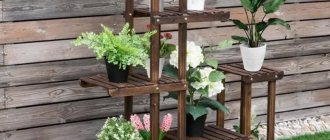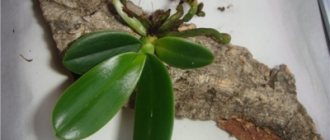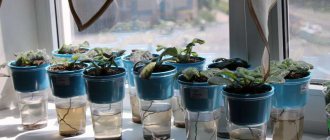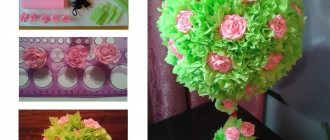There is absolutely no need to buy an orchid pot in the store. You can create a beautiful and functional flowerpot with your own hands. Any available materials are suitable for this: from the simplest to the exotic.
When manufacturing, it is necessary to take into account the characteristics of orchids, most of which are epiphytes and lithophytes. Errors in the design can lead to plant disease, or even its loss.
Primary requirements
The best pot for orchids is transparent, with smooth inner walls and plenty of drainage and ventilation holes , such as plastic. These requirements are due to the fact that:
- orchid roots participate in photosynthesis ; direct access to light is vital for them;
- the roots try to cling to any surface, including the walls of the pot; if the inner surface is rough, the roots will definitely take advantage of this; when replanting an orchid, there is a high probability of damage to them, which is undesirable;
- the roots do not tolerate stagnation of moisture , which means that high-quality drainage is needed to ensure rapid removal of water;
- To protect against rotting, good ventilation is also necessary, literally “bathing” the roots in the air.
Special orchid baskets made from various materials that meet the specified requirements are also suitable.
The general wish for orchids is sufficient, but not excessive volume.
Consequences of the wrong choice
The wrong choice of container can lead to the death of the entire plant. The fact is that the root system of the plant begins to rot. This leads to the formation of algae on the walls. Also, in some cases, snails may appear. The flower itself begins to hurt and eventually dies.
There are different types of orchid pots. They are made from various materials and can also have various types of decor. There are transparent and opaque flowerpots .
These vessels:
- can be purchased in the store;
- you can create it yourself.
In the second case, the use of any available materials is allowed. This process is labor-intensive and requires a certain amount of patience from the person performing it.
However, as a result, you can get an absolutely unique and high-quality item.
You cannot grow orchids in pots . These containers play an exclusively decorative role and are a beautiful shell for the pot in which the beautiful flower is actually grown. When choosing a vessel for this plant, you should also remember that the material plays the main role, and the decor is just an additional bonus.
DIY orchid pot
You can make your own orchid pot from various materials. It is important to follow the basic rules - lighting, aeration, drainage, smooth walls.
Options
You can make a container for planting an orchid with your own hands in the following ways:
- A simple orchid can be made from a transparent or translucent food-grade plastic container if you make a large number of drainage holes in the bottom and lower part of the walls;
Advice! Beautiful holes can be easily made using a hot soldering iron or a nail.
- A similar container is obtained from a plastic pet bottle ; craftsmen also arrange some kind of hydroponics and aeroponics system;
- Experienced craftsmen who prefer eco-style make beautiful eco-friendly orchids from tree bark , which can be placed on a stand or hung;
- A recess is made in the cut of the tree (in the stump), drainage holes are drilled and an original pot is obtained from a piece of wood;
- Successful baskets for orchids made from wooden dies and scraps of plastic;
- Beautiful graceful arboretum orchids are obtained from a transparent glass vase . Here it is important to pay attention to the timely removal of excess moisture and ventilation;
- Orchids are made from a ceramic vessel by drilling several large drainage holes in the bottom and in the lower part of the side surfaces;
- Small aquariums are adapted for breeding orchids ;
- The most difficult and controversial way is to cast pots from plaster or sand-cement mixture , there are also such flower growers. But such containers are least suitable for orchids, unless numerous holes are immediately made in them during manufacture.
Advantages and disadvantages
The advantages of a self-made orchid pot are rightfully considered:
- originality and uniqueness of the art object;
- the ability to make a container without additional financial costs, from auxiliary materials;
- the ability to make a pot that matches the size and characteristics of the plant specimen, organically fitting into the interior of the room, corresponding to the taste of the gardener.
A coconut flowerpot will fit perfectly into an ethno-interior.
Attention! Homemade orchids from food containers and plastic bottles comply with all the rules for growing orchids.
Possible disadvantages of the craft:
- insufficient grinding of internal surfaces, for example, wooden or clay;
- insufficient aeration of glass and ceramic containers;
- lack of quality drainage.
Varieties of orchid pots
Literally translated from French, the word “cache-pot ” means “to hide a pot.” In essence, this is a decorative container that decorates floral functional dishes. Unlike other indoor pots, orchid decor must meet strict requirements that are associated with the peculiarities of growing epiphytes at home:
- It is desirable (although not necessary) that the material for the pots be transparent , just like an orchid pot. The root system of an orchid, just like the leaves, needs lighting. By the appearance of the root system it is easy to judge the condition of the plant. For example, if the roots are bright green, then there is enough moisture. When a whitish coating appears on the surface, it is time for the next watering. Through the transparent walls of the pots you can clearly see how the roots behave.
- The size of the decor should be larger so that the pot fits completely freely in it. This is due to the aeration of the plant. Orchid roots need a lot of air. Crowding can cause stagnation of air and moisture, which leads to plant disease.
Tip #1 . When choosing a pot for orchids, remember that the functional features of the stand are more important than the decorative ones. First you need to make sure that the device will not harm the plant. And only after that pay attention to the decorative nature of the container itself.
Manufacturing technology
From plastic bottles
Orchidists have come up with several ways to make containers from plastic bottles of different sizes.
Options
A five-liter bottle of drinking water makes an excellent greenhouse for nursing a diseased plant or for creating a composition. Smaller volume PET bottles are suitable for creating small containers, even with an automatic watering system.
PET pots with automatic watering.
Technology
How to make a self-watering system? To do this, take 2 bottles of 1 and 2 liters.
Cut a two-liter bottle crosswise at a height of approximately 20 cm from the bottom. Make 8 cuts, 4 cm long, perpendicular to the upper edge of this lower part. Bend the resulting petals inside the container.
The neck is cut off from the upper part and inserted into a pre-prepared hole in the base (lower part). Secure with glue using a hot-melt gun.
Now cut a small bottle in the same way, at a height of 15 cm from the bottom. The upper part is bent outward, in a strip of about 1 cm. Several holes are made in the bottom with a hot nail, knife or soldering iron, and a long hanging woven cord (7–8 cm) is passed through them.
Fill the pot with substrate and plant the orchid.
This part of the structure is lowered into the base container so that it is held suspended by the previously concave petals. Water is poured into a large container. Moisture will gradually flow through the woven cords into the upper pot.
Attention! Water is added through a spout inserted into a cut in the lower part of the structure.
Made of wood
Orchid pots can be made from wood in several ways.
From a stump
In the first case, they take a piece of log - a stump, also known as a log. The size depends on where the plant will be located and the size of the specimen:
- for large orchids, a floor pot made from a whole piece of wood is suitable;
- for a compact one, a piece of wood the size of a 0.5–1 liter jar is sufficient.
At one end, blind holes are drilled around the circumference with a drill, as close to each other as possible. Then, using a chisel and hammer, remove the marked middle, level it, and sand it with sandpaper.
Then, in the resulting bottom of the future pot, drainage holes must be made . There should not be enough of them, because not only the health of the plant, but also the durability of the container itself depends on high-quality drainage and moisture removal. If the bottom area is small, you can drill holes in the lower part of the side surfaces.
Hemp pots.
Internal surfaces are treated with a non-aggressive deep impregnation antiseptic. On the outside, it is also useful to treat the wood with a protective compound; this will extend its service life and maintain its attractive appearance for a long time.
If desired, the wooden pot is decorated , for example, with jute twine.
Basket of dies
Another way to make a container for an orchid from wood is a traditional orchid basket made from wooden blocks. To do this, take bars of the same size; slats made of oak, beech, pine or bamboo sticks with a diameter of 10 mm are suitable.
Holes are made along each edge of the workpiece with a thin drill.
Attention! To make the basket even, the holes must be exactly the same distance from the edge of the slats.
Thoroughly sanded and coated with a protective compound. To do this, you can immerse the workpieces in an impregnating wood antiseptic for a couple of hours, and then dry for 1-2 days.
We assemble the frame of the future bottom from strong wire, attach pieces of wire perpendicular to the corners, slightly longer than the height of the future basket. We string the first two bars onto the wire from opposite sides, threading the wire through the holes. This is the basis.
We attach several others to these bars, arranging the bottom. The dies can be attached to the base with small screws.
Then we attach the bars to the wires one by one, tighten them firmly from above, making loops (you can use round nose pliers). Another option is to tie the wire in a knot under the bottom. For large orchids, it is preferable to weave the bottom from strong wire.
This pot is not only environmentally friendly, it has better drainage and aeration than others.
From planks
A box is assembled from thin planks or plywood, having previously treated each part with an antiseptic. For fastenings, it is better to use small nails, wire or screws, but not glue.
For a tabletop wooden pot box, it is worthwhile to provide outlets - legs. For a wall composition, one side is made larger; it will serve as a panel to which the container with the plant is attached.
How to grow Phalaenopsis
The very first rule: the plant does not tolerate waterlogging of the root system.
The container for the plant must provide:
- drainage of excess water
- good air exchange in the root system and substrate,
- safe root extraction,
- ideal temperature.
Some varieties not only absorb nutrients and water by their roots, but also take an active part in photosynthesis. These plants need a transparent pot.
These plants do not require a lot of space, since their root system is weak, and they simply may not master the volume of the substrate. Therefore, it is better to choose a medium-sized pot.
The main conditions when choosing the right pot are:
- presence of drainage holes,
- the height must be equal to the width of the container,
- the volume of the container must correspond to the size of the plant’s rhizome.
- It would be good if the flowerpot comes with a stand.
Most often, the flower is planted in plastic or ceramic flowerpots. There are even very beautiful containers in the form of baskets on sale - in them the roots will breathe and develop perfectly.
It is better not to buy a glass container, as it can cause injury not only to the plant, but also to humans. In addition, the glass container prevents air exchange. It can be used as a planter for an orchid in a plastic transparent pot.
How to make a hanging flowerpot at home?
An orchid in a hanging pot looks impressive and becomes the main accent in the interior. Several methods of making this design detail are popular:
- twine, thin wire or fishing line are attached to the corners of the orchid basket described just above - and the hanging pot is ready;
- You can hang any container with an orchid in a basket made of twigs or wire. To do this, you need to weave a basket slightly larger than the selected pot, place a vessel in it, hang the basket on a hook fixed in the ceiling or on the wall;
- 3 or more holes are drilled along the edge of any pot, twine, fishing line, wire or a decorative thin chain are attached to them. Fasten at one point at an arbitrary (desired) length and hang.
One of the options for hanging flower pots.
Unusual containers
To create original art objects with orchids, you can use other materials at hand.
Made from natural bottle caps
Miniature orchids look original in bottle caps made of natural material. To do this, remove a little porous material from the end of the cork with a narrow knife, place the roots of the orchid inside, and secure the plant with soft thin wire or fishing line.
Using a heat gun, a magnet is attached to one side of the cork, and the composition is attached to a metal surface.
Advice! You can create a composition from several of these cork pots by attaching them to the base of the panel.
From pieces of tree bark
More often, the bark is used to make blocks on which epiphytes are planted.
If desired, you can plant the orchid in any other container. Cover it tightly with thin pieces of bark, tie it tightly with wire, which is decorated with moss or jute.
From a vinyl record
When heated, vinyl records become plastic, they make nice stylish planters, they can be given any fancy shape.
Vinyl record pot.
Baskets
Orchids are placed in baskets made of plastic, wood, wire, or bamboo. Bamboo is considered the most successful - it is a natural material with a smooth surface that prevents root growth:
- One or more containers with orchids are placed in baskets of various shapes and sizes. But more often, orchids are planted directly in baskets filled with substrate;
- Another option is to lay the bottom and walls of the basket with sphagnum, place the main substrate on it, plant an orchid and hang the structure.
Important! Baskets are considered one of the most correct ways to plant orchids. They are second only to blocks.
From coconut
Another natural material, beautiful, comfortable, ideal for orchids is coconut shell. To do this, the nut is cut, the core is removed, cleaned, and dried.
Holes are drilled in the rounded bottom and along the edges, and half of the shell is filled with substrate. Thin chains, fishing line or wire are passed through the holes located along the edges and the “live” composition is suspended from the ceiling or wall.
Pot size
Container size is very important for root health . Buying a pot that is not the right size for the flower is dangerous for the orchid.
It is best to be guided by the following ratio: the width is created equal to the height of the flower. To avoid root rot and uneven drying of the soil, as well as effective aeration, do not choose a container larger than the height of the flower.
Small pots for orchids are also not useful. In them, an adult orchid turns over and is seriously injured.
Important! Crowding is harmful for the roots, as they are too densely intertwined and some of them die or rot due to poor aeration.











